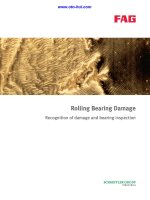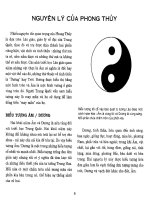Rolling Bearing Damage 2009 Part 2 potx
Bạn đang xem bản rút gọn của tài liệu. Xem và tải ngay bản đầy đủ của tài liệu tại đây (124.43 KB, 7 trang )
Unusual operating behaviour indicating damage
Bearing monitoring with technical devices
FAG 6
40 60 80 100 120 140 160 180 200
Undamaged bearing
Damaged bearing
Vibration acceleration
0,086g
0,086g
0
Frequency [Hz]
Side
bands
Side
bands
Harmonic
f
IR
n
IR
20
0
n
IR
2f
IR
n
IR
n
IR
3f
IR
n
IR
n
IR
4f
IR
5: Frequency spectrum of envelope signal between 0 and 200 Hz,
below: undamaged bearing; above: damaged bearing
n
IR
Inner ring speed [min
–1
]
f
IR
Frequency of inner ring signal (cycling frequency) [Hz]
6: Inner ring damage to a spherical rol-
ler bearing in a paper making machi-
ne found by means of the
envelope detection procedure.
04812162024min
Operation time
80 40
100
120
140
160
60
80
100
300
Temperature
°C
Shock value
Lubrication stopped
7: March of temperature and shock value as a function of time stopping
lubrication. Spindle bearing B7216E.TPA; P/C = 0.1; n = 9000 min
–1
;
Lubricating oil ISO VG100.
1.2.2 Damage in certain spots
Should bearing damage be restricted
to specific locations such as indentations
caused by rolling elements, standstill
corrosion or fractures, it can be re-
cognised at the earliest with vibration
measurements. Shock waves which
originate from the cycling of local inden-
tations can be recorded by means of
path, speed and acceleration pick-ups.
These signals can be processed further at
little or great expense depending on the
operating conditions and the accuracy of
the expected confidence factor. The
most common are:
– measuring effective value
– measuring shock value
– signal analysis by envelope detection.
Experience has shown that the latter
procedure is particularly reliable and
practical in use. The damaged bearing
components can even be pinpointed
with a special type of signal processing,
figs. 5 and 6. Please refer to our TI No.
WL 80-36 >Rolling Bearing Diagnosis
with the FAG Bearing Analyser<" for
more information.
Unusual operating behaviour indicating damage
Bearing monitoring with technical devices · Urgency of bearing exchange
7 FAG
The vibration measuring procedures
are very suitable for detecting fatigue
damage. It is easiest with bearings with
point contact (ball bearings) and with
more sophisticated evaluation proce-
dures such as envelope detection, for ex-
ample, damage to roller bearings is
found just as reliably. They are less suit-
able, however, for observing the lubrica-
tion condition. A fault in the lubricant
supply can be reliably spotted by tem-
perature measuring, as described above.
This is particularly well illustrated in
figure 7. The shock value is far less sen-
sitive than the temperature sensor.
Hence, in the case of expensive technical
plants, temperature and vibration
measurements complement one another
ideally.
8: Development of fatigue damage on the inner ring raceway of an angular contact
ball bearing. The periodic intervals between inspections from damage begin on,
are given in percentage of the nominal life L
10
.
1.3 Urgency of bearing exchange –
remaining life
Once bearing damage has been detec-
ted, the question arises as to whether the
bearing must be exchanged immediately
or whether it is possible to leave it in
operation until the machine's next sche-
duled standstill. There are several condi-
tions which must be given consideration
before making any decision. If, for ex-
ample, reduced working accuracy of a
machine tool is reason to suspect bearing
damage, the urgency of bearing exchan-
ge primarily depends on how long parts
can continue to be produced without
lacking in quality. Bearings which block
suddenly at a high speed due to hot run-
ning caused by an interruption in lubri-
cant supply going unrecognised, must be
replaced immediately, of course.
In lots of cases a machine may remain
in operation without the quality of the
product suffering despite damage. How
long it may do so depends on the bear-
ing load, speed, lubrication, and lubri-
cant cleanliness. Extensive examinations
have been made on ball bearings on the
progress of damage under various loads.
The main results are as follows:
Unusual operating behaviour indicating damage
Urgency of bearing exchange
FAG 8
12
10
8
6
4
2
0
010203040
Size of damage in % of track circumference
Period of operation with damage [% L
10
]
9: Size of damage based on the running time after damage recognition
(when approx. 0.1% of track circumference is flaked)
– With a moderate load, damage
develops very slowly so that it is
normally not necessary to replace the
bearing prior to the next scheduled
standstill.
– With an increasing load, damage
grows far more quickly.
– The damage develops slowly first but
as it becomes larger it spreads faster.
Figures 8 (page 7), 9 and 10 illustrate
these findings.
1 900 2 000 2 100 2 200 2 300 2 400 2 500 2 600
30
25
20
10
15
5
0
max. Hertzian contact pressure [MPa]
mean running time after damage recognition [% L
10
]
10: Mean remaining running time of angular contact ball bearings after recogni-
tion of fatigue damage based on stress condition until 1/10 of the track circum-
ference is damaged. Operating condition prior to first signs of fatigue
damage: Utmost cleanliness in EHD lubricating gap.
Securing damaged bearings
Determination of operating data · Extraction and evaluation of lubricant samples
9 FAG
– Case of application:
machine (device), bearing location,
attained life, how many similar
machines and how many failures in
these machines
– Bearing construction:
locating bearing, floating bearing
floating bearing arrangement
adjusted bearings (loose, rigid; with
spacers, via fitting washers)
– Speed:
constant, changing (inner ring and
outer ring)
acceleration, deceleration or retarda-
tion
– Load:
axial, radial, combined, tilting
moment
constant, changing (collective)
oscillating (acceleration, oscillation
amplitude)
centrifugal force
point load, circumferential load
(which ring is rotating?)
– Mating parts:
shaft seat, housing seat (fits)
fastening parts (e.g. type of locknut,
elastic bolts etc.)
– Environmental conditions:
external heat, cooling
special media (e.g. oxygen, vacuum,
radiation)
vibrations in standstill
dust, dirt, dampness,
corrosive agents
electric or magnetic fields
– Lubrication:
lubricant, lubricant quantity
lubricant supply
relubrication interval
date of last relubrication interval/last
oil change
– Sealing
contact, non-contact
– History of damaged bearing:
first mounting or replacement bear-
ing
changes in bearing location/machine
in the past
failure frequency so far
calculated L
10
life
life normally attainable
particularities during operational
period up to now
repairs on other machine parts (con-
struction measures, welding)
machine trouble due to other
machine elements (e.g. seal damage,
loss of oil)
distance and means of transport of
the machine or bearings
packaging
– Evaluate records and charts from
bearing monitoring devices if avail-
able
2.2 Extraction and evaluation of
lubricant samples
Lubricants can reveal diverse indica-
tions of damage causes in rolling bear-
ings. Suitable test samples are a must
(only with open bearings), please refer to
DIN 51750, ASTM Standard D270-65
and 4057-81.
– Grease lubrication:
• Documentation of grease distribu-
tion and colour in the bearing en-
vironment
• Extraction of samples from differ-
ent places in the bearing and bear-
ing environment with correspond-
ing marking
– Oil lubrication:
• Remove samples from the oil flow
near the bearing or from the
middle of the supply container
• Extract samples during machine
operation or directly after in order
to obtain a typical distribution of
foreign matter
• Do not remove samples from the
bottom or from directly behind
filters (wrong concentration of
particles)
Should a bearing be removed from a
machine due to damage the cause of the
latter must be clarified as well as the me-
ans to avoid future failure. For the most
reliable results possible it is practical to
follow a systematic procedure when se-
curing and inspecting the bearing. By
the way, several of the points listed be-
low should be given consideration when
inspecting bearings dismounted during
preventive maintenance.
Recommended sequence of measures:
– Determine operating data, evaluate
records and charts from bearing
monitoring devices
– Extract lubricant samples
– Check bearing environment for ex-
ternal influence and other damage
– Assessment of bearing in mounted
condition
– Mark mounting position
– Dismount bearing
– Mark bearings and parts
– Check bearing seats
– Assessment of complete bearing
– Examination of individual bearing
parts or dispatch to FAG
Important factors required for finding
the cause of damage may be lost forever
if the procedure selected is not suitable.
Faults made when the damaged bearing
is being secured can also disguise the
damage pattern or at least make it ex-
tremely difficult to correctly explain the
damage features.
2.1 Determination of operating
data
Not only the bearing itself is exami-
ned when rolling bearing damage is
being inspected but the environmental
and application conditions are also
checked in advance (with an assembly
drawing if possible).
2 Securing damaged bearings
Securing damaged bearings
FAG 10
• Independent of the oil samples,
filter residue should also be kept
for inspection (indication of
history prior to damage)
– General
• How often had the bearing been
relubricated or had the oil been
changed? When was either last
carried out?
• Check oil or grease for any pieces
broken off the bearing or other
components
• Use clean vessels for the samples.
They should be made of suitable
material (glass, for example)
• There should be enough room left
in the vessel for stirring the oil
sample in the laboratory
• The analysis of the samples may
take place at the customer's, in an
external lubricant laboratory or at
FAG. Points of interest are gener-
ally the degree of contamination
and its type (sand, steel, soft little
parts, water, cooling liquid) as well
as an analysis of the lubricity
(eg. ageing, consolidation, colour,
coking, share of additives). If
possible, a sample of fresh grease or
oil should be handed on and ex
amined as well (in the case of un-
known lubricants, effects of heat)
2.3 Inspection of bearing
environment
– Could surrounding parts have grazed
against bearing parts anywhere?
– Are any other parts close to the bear-
ing damaged (consequential or
primary damage)?
– Cleanliness within and externally to
seals (any foreign matter in the bear-
ing space?)
– Loosening force of bearing fastening
parts (was the bearing forced to de-
form? Are the bolts loose?)
2.4 Assessment of bearing in
mounted condition
– Are there any ruptured or chipped
areas?
– Are the seals damaged, particularly
deformed or hardened?
– Is the bearing deformed at the visible
areas?
– Can scratches by foreign matter be
detected?
– Does the bearing run easily or tightly
in mounted condition? (fit effect)
2.5 Dismounting damaged
bearing
Great care should be given not to
distort the damage pattern when dis-
mounting a damaged bearing. If this is
not possible damaged caused when dis-
mounting should be marked and noted
down. The following procedure should
be observed if possible:
– Do not apply dismounting force via
the rolling elements
– High dismounting force could be an
indication of disturbed floating bear-
ing function
– Do not open sealed bearings
– Do not destroy or damage heat-sensi-
tive parts (lubricant, seal, cage) by
heating too much
– Mark bearing (mounting location,
mounting direction)
2.6 Seat check
– Shaft and housing dimensions (detri-
mental preload, seats too loose)
– Form tolerances of seats (oval defor-
mation)
– Roughness of seats (excessive material
loss)
– Fretting corrosion (varying degrees
indicate uneven support, load direc-
tion)
2.7 Assessment of complete
bearing
The bearings should always be
handed over uncleaned, i.e. with lubri-
cant remains, for assessment.
The following should be checked:
– General condition (cleanliness of
bearing and condition of fitting sur-
faces, i.e. traces of mounting, fretting
corrosion, ring fractures, dimensional
accuracy, seizing marks, discoloura-
tion)
– Condition of seals and dust shields.
Photograph or description of place
and extent of any grease escape.
– Condition of cage
– Manual rotation test (indication of
contamination, damage or preload)
– Measure bearing clearance (displace-
ability of rings in radial and axial di-
rection), whereby bearings are loaded
equally and rotated!
2.8 Dispatch to FAG or
assessment of individual parts
of bearing
The causes of failure basically possible
can be detected very often by customers
themselves or by an FAG employee on
the site. Whether more specific examina-
tions are required or not depends on the
distinctness of each damage feature. The
procedure for examining individual
bearing parts is described in detail below.
If it is quite obvious that an examina-
tion is to be made at FAG the parts
should be prepared for dispatch as
follows:
– neither dismantle the bearing nor
clean it. On no account should cold
cleanser or gasoline be used for
rinsing (otherwise lubrication hints
disappear, corrodibility).
Securing damaged bearings · Evaluation of running features and damage
to dismounted bearings
11 FAG
– Avoid contamination after dismount-
ing. Pack the bearings separately in
clean foil if possible, since paper and
cloths remove oil from the grease.
– Select sufficiently strong and thick
packaging to prevent damage arising
during transport.
Bearing damage may not always im-
ply a complete failure of a rolling bear-
ing but also implies a reduction in the
efficiency of the bearing arrangement. In
this context it should be remembered
that the earlier the particular bearing is
dismounted the sooner the source of
trouble can be detected.
A bearing arrangement can only func-
tion smoothly if the operating and en-
vironmental conditions and the compo-
nents of the arrangement (bearings,
mating parts, lubrication, sealing) are
correctly coordinated. The cause of bear-
ing damage does not always lie in the
bearing alone. Damage which originates
from bearing material and production
faults is very rare. Prior to inspecting
bearing damage by means of individual
parts the possible damage sources should
be studied based on the facts found
according to Section 2. The operating
conditions or external features of the
bearing frequently provide an indication
of the cause of damage. The table in
fig. 12 illustrates the main damage
features in rolling bearings with their
typical causes.
This summary cannot take all types of
damage into account but just provide a
rough outline. It should also be kept in
mind that a number of damage patterns
are exclusively or almost only found with
certain types of bearings or under special
application conditions. In many cases
one bearing may reveal several damage
features concurrently. It is then frequent-
ly difficult to determine the primary
cause of failure and a systematic clarifi-
cation of diverse damage hypothesis is
the only answer. The systematic proce-
dure described below is recommended
for such cases.
3 Evaluation of running features and damage to dismounted
bearings
11: Causes of failure in rolling bearings (Source: antriebstechnik 18 (1979) No. 3,
71-74). Only about 0.35% of all rolling bearings do not reach expected life.
20 % unsuitable
lubricant
20 % aged
lubricant
15 % insufficient
lubricant
20 % solid
contamination
5 % liquid
contamination
5 % consequential damage
5 % mounting faults
10 % unsuitable choice of bearing
(design, size, load carrying
capacity)
<1 % material
and production faults
Evaluation of running features and damage to dismounted bearings
FAG 12
12: Rolling bearing damage symptoms and their causes
Symptom Damaged area of bearing Typical causes of rolling bearing damage
Mounting
Seats Rolling Lip Cage Sealing Incorrect Dirt Fit too Fit too Poor Misalignment
contact and mounting tight, loose, support or
areas roller procedure too much too little of shaft
face or preload preload rings deflection
areas tools
a) Unusual running
behaviour
Uneven running ■■ ■
Unusual
noise ■■■■ ■■
Disturbed
temperature behaviour ■■
b) Appearance of dis-
mounted bearing parts
1 Foreign particle
indentations ■■
2 Fatigue ■■■■■■
3 Stationary
vibration marks ■
4 Molten dents
and flutes ■
5 Skidding ■■
6 Rolling element
indentations, scuffing ■■ ■
7 Seizing marks ■■■
8Wear ■■■■ ■
9 Corrosion ■■■■
10 Overheating damage ■■ ■■■ ■
11 Fractures ■■ ■■ ■ ■ ■
12 Fretting corrosion
(false brinelling) ■■■









